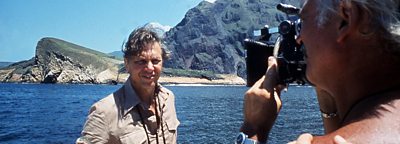Considered by many as the 'jewel in the crown' of the ����ý's output, natural history series have entertained, engaged, and captivated audiences at home and abroad for more than seventy years. They have allowed viewers to share in the passion for wildlife, the environment, and Planet Earth so clearly held by producers and presenters such as Desmond Hawkins, Johnny Morris, Tony Soper, and David Attenborough.
Early Days
The long tradition of natural history programmes goes back to the immediate post-war period when Desmond Hawkins, who had recently joined the ����ý’s West Region in Bristol, produced a radio series for the Home Service called The Naturalist. His love of birds, wildlife, and nature led to his developing programmes within this ‘genre’, initially for radio and later, as we shall see, for television.
Other programmes followed, including Birds in Britain, broadcast on the Home Service and listened to attentively by a large audience, including a young boy by the name of David Attenborough.
Hawkins was keen for The Naturalist to be open and accessible to listeners of all kinds, not just what he called ‘cult friends’. In his ����ý Oral History interview with Frank Gillard in 1989, he outlined his vision for the series and the method he used for ensuring that the programme had wide appeal:
The Natural History Unit
By the early 1950s, when television was beginning to plough its own furrow, it became clear that television lent itself to natural history programming and that the new medium had great potential in the field. Given the lead the West Region had taken in producing nature programmes, it was natural that pressure should be placed on management in London to set up a Natural History Unit (NHU) in Bristol.
In addition to Desmond Hawkins, Frank Gillard the Head of the ����ý’s West Region, pushed for the Unit, and in 1957 the NHU was established. It was a key decision in television history, and laid the foundations for the production of a host of award-winning programmes and series.
Given the standards and relatively large budgets of natural history productions and co-productions today, it’s easy to lose sight of the humble beginnings of the NHU. In his Oral History interview, Desmond Hawkins explained how he had to beg for the smallest of resources, but then how things improved once a successful series, had been launched:
Hawkins’ assistant was Plymouth-born Tony Soper. Soper had worked in radio on Birds in Britain and then on the Look series as the film producer before moving into presenting. Here, he recalls how he had to be resourceful in the face of a shortage of facilities:
Although the natural history expertise was in Bristol, the technical expertise and equipment lay in the television studios in London, in Lime Grove at this point. As Soper explained:
"We had no film cutting facilities, we had no telecine machine – we didn't have the machines which run film, so that the telecine, the film element of the programmes was played in, again, from London, so that we had the people, the live element, the people talking in the studio here, the sort of make-shift studio, in Bristol with live cameras and then in the gallery, in the sort of control area we... and then in the gallery, in the control room, we would be in telephone contact with the telecine people in London. So at the appropriate moment and it was usually my job - you'd be listening to them talking and then they would give the cue word of some kind and I would say 'Run Telecine' and the guy in London would press the button there and magically up would come the film".
Natural History and Children
In an attempt to make natural history programming accessible to all, Children’s programming has always made attempts to spark children and young people's interests in the natural world. One programme which did this successfully over a period of over twenty years was Animal Magic.
Animal Magic hosted by Newport-born Johnny Morris and was broadcast between 1962 and 1983. Together with Tony Soper and other presenters, Morris introduced the animal world to younger people in the guise of a keeper at Bristol Zoo who would interact with animals – Morris himself providing voices for the various creatures.
Over 440 episodes were transmitted although many of these were destroyed in the 1990s by the ����ý as they were thought to have no archival value, anthropomorphic animals having fallen out of favour with audiences (although they have since made a comeback in C����ý’s The Zoo).
In this interview from 1987 Monica Sims, who was Head of ����ý Television Children’s Programmes between 1967 and 1978, explained the important role of natural history programming in the children’s schedule. She also underlined the importance of engaging children with animals and nature through other programme formats:
David Attenborough
One of the pioneers in television natural history programmes is David Attenborough, a zoologist who started working for the ����ý in October 1952, mainly thanks to the Head of Talks, Mary Adams, who saw from his CV that he had potential as a producer within the new television service (having been rejected for a similar post in radio).
Attenborough first worked on Animal, Vegetable, Mineral?, choosing artefacts for a panel of experts to discuss, but also directing in the studio at Alexandra Palace. In 1954, he began to present a new natural history programme, Zoo Quest.
In an interview with Robin Scott in 1980, he explained how the programme came about:
When the Natural History Unit was established in 1957, Attenborough was asked to be its first head. He declined the offer, citing family reasons (he had a young family with him in London and he felt that the move would be unsettling).
Despite turning down this opportunity, David Attenborough recalled receiving support for his programming ideas from Controller of Television Cecil McGivern, just as Desmond Hawkins did. Here he talks about McGivern’s insistence that whatever else it was, television had to be exciting every evening.
After a period away from full-time programme-making – Attenborough became Controller of ����ý Two in 1965 and Director of Programmes for ����ý One and ����ý Two in 1969 – he returned to tackle the first of a number of large, ambitious series – Life on Earth.
Whilst at the helm of ����ý Two, Attenborough had realised that colour (launched on the channel in 1967) could revolutionise natural history programmes. Life on Earth (1979), and the sequel, Living Planet (1984) utilised the latest technology to create pioneering televisual series.
There is no doubting David Attenborough’s passion for the natural world, and for making programmes which inform, educate, and entertain audiences – despite the amount of work involved. This is clear from the oral histories. Here he is talking with Norman Swallow and Alan Lawson in an interview for the British History Entertainment Project:
Natural History – entertaining and campaigning
Over time, whilst the central aim of natural history programming has been to engage audiences with the natural world, there has been a shift of emphasis in recent times. Climate change and habitat destruction are now as likely to feature on ����ý natural history programmes as the mating habits of Orangutans.
In this interview, Tony Soper talks of a campaigning spirit which characterised the NHU and the need to balance this with getting a large audience. He also discusses the importance of promoting the awareness of the relationship between people and animals:
Commercially, the ����ý’s natural history programmes have proved lucrative to the Corporation, and thanks to their high production values, have sold well overseas. Blue Planet II, for example, was sold across the globe.
The Corporation continues to support an award-winning centre of excellence in Natural History in Bristol and the productions and international co-productions from that stable will inform, educate, and entertain for many years to come.
Further reading
- Jean-Baptiste Gouyon, ����ý Wildlife Documentaries in the Age of Attenborough (Palgrave, 2019).
- Jean Seaton, 'Attenborough, the public service animal’ in Pinkoes and Traitors: the ����ý and the nation, 1974–1987 (2017)

